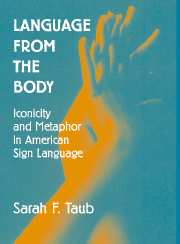Book contents
- Frontmatter
- Contents
- List of Figures
- Acknowledgments
- 1 A Glimpse of the Material
- 2 Motivation and Linguistic Theory
- 3 Iconicity Defined and Demonstrated
- 4 The Analogue-Building Model of Linguistic Iconicity
- 5 Survey of Iconicity in Signed and Spoken Languages
- 6 Metaphor in American Sign Language: The Double Mapping
- 7 Many Metaphors in a Single Sign
- 8 The Vertical Scale as Source Domain
- 9 Verb Agreement Paths in American Sign Language
- 10 Complex Superposition of Metaphors in an American Sign Language Poem
- 11 The Future of Signed-Language Research
- Appendix 1 Glossing Conventions
- Appendix 2 Translation of “The Treasure”
- References
- Index
7 - Many Metaphors in a Single Sign
Published online by Cambridge University Press: 16 October 2009
- Frontmatter
- Contents
- List of Figures
- Acknowledgments
- 1 A Glimpse of the Material
- 2 Motivation and Linguistic Theory
- 3 Iconicity Defined and Demonstrated
- 4 The Analogue-Building Model of Linguistic Iconicity
- 5 Survey of Iconicity in Signed and Spoken Languages
- 6 Metaphor in American Sign Language: The Double Mapping
- 7 Many Metaphors in a Single Sign
- 8 The Vertical Scale as Source Domain
- 9 Verb Agreement Paths in American Sign Language
- 10 Complex Superposition of Metaphors in an American Sign Language Poem
- 11 The Future of Signed-Language Research
- Appendix 1 Glossing Conventions
- Appendix 2 Translation of “The Treasure”
- References
- Index
Summary
SINGLE-PARAMETER METAPHORS
So far we have looked at metaphorical iconic signs that present complete pictures of little scenes; for example, i-inform-you (see Fig. 6.4) is in effect a portrayal of ideas being taken out of one's head and tossed to someone else. In these signs, every formational parameter (movement, handshape, location, etc.) takes part in the same consistent mappings from linguistic form to a source domain and from source to target domain.
But recall how for purely iconic signs, the form doesn't have to give a complete picture: Although a single aspect or parameter of the form might resemble one aspect of the referent, the rest of the form is noniconic. Our example of this was iconic time ordering of clauses in both signed and spoken languages: Each clause may or may not resemble the event it refers to, but the temporal sequence of clauses does present an analogue for the temporal sequence of events.
The same is true for metaphorical iconic signs. As Brennan (1990) noted for British Sign Language, there are a number of signs in which only one or two formational parameters are metaphorical, and other signs in which some parameters are motivated by one metaphor and others by a different one. In these cases, the conceptual mappings involved tend to be fairly sparse, consisting of only one or two correspondences, and thus they can easily be represented by a single parameter such as direction of motion.
- Type
- Chapter
- Information
- Language from the BodyIconicity and Metaphor in American Sign Language, pp. 114 - 137Publisher: Cambridge University PressPrint publication year: 2001



